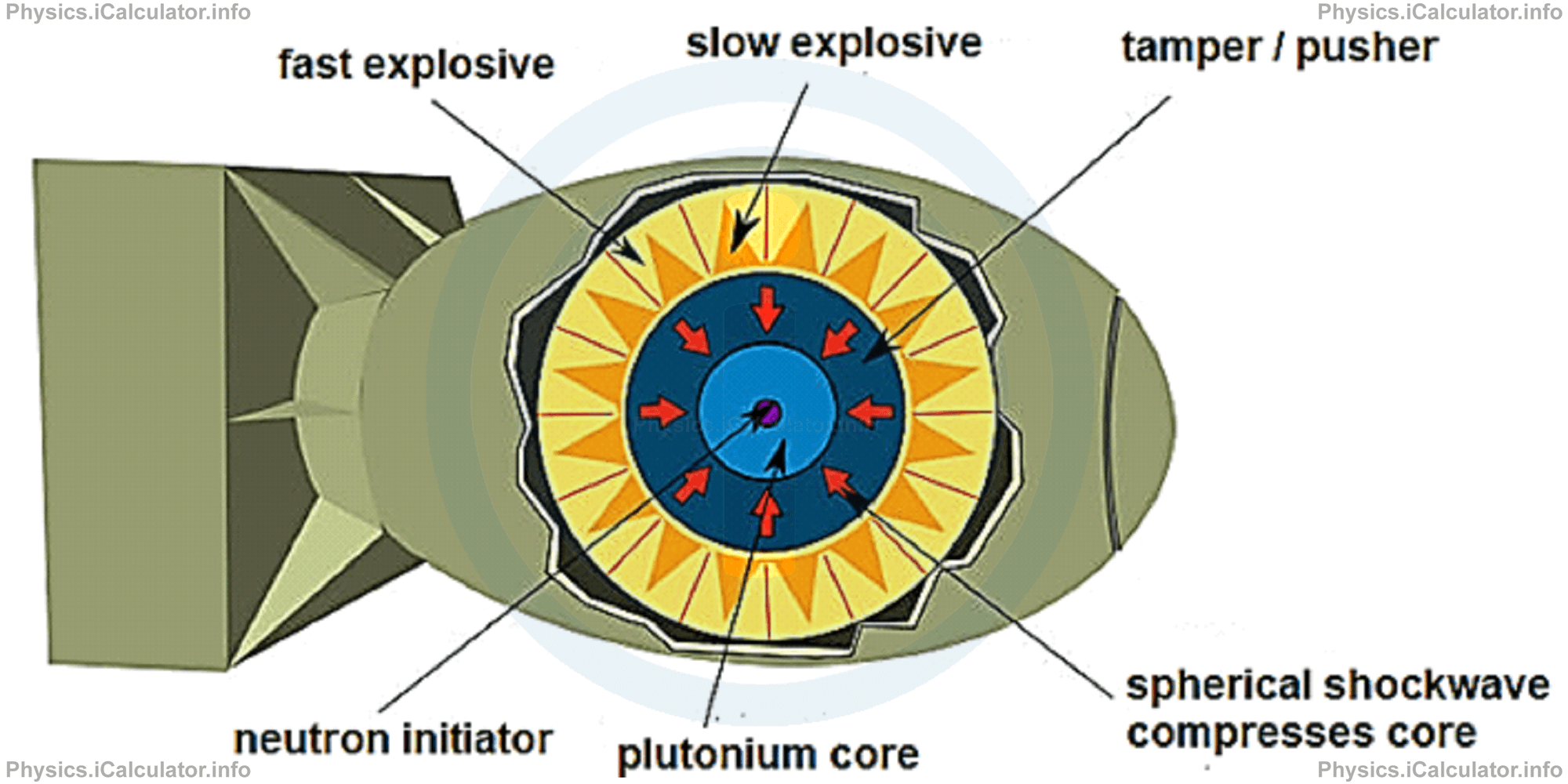Menu
Physics Lesson 20.4.8 - Nuclear Bombs
Please provide a rating, it takes seconds and helps us to keep this resource free for all to use
Welcome to our Physics lesson on Nuclear Bombs, this is the eighth lesson of our suite of physics lessons covering the topic of Nuclear Reactions, you can find links to the other lessons within this tutorial and access additional physics learning resources below this lesson.
Nuclear Bombs
Nuclear bombs also use the fission process but unlike in nuclear reactors, the process here is in supercritical state, i.e. the nuclear reactions are quite non-controllable. This means the chain process rate is in continuous acceleration and the energy delivered remains practically in the region in which the fission takes place. This brings a very high increase in temperature. The products obtained through fission are radioactive and they acquire high kinetic energy. Gamma radiation obtained through fission process after the explosion has a very high energy and intensity. This brings a powerful explosion, during which the fission products spread out at very high speed in all directions. The energy released caused high deformations in everything in the surrounding area while gamma radiation and radiation caused by radioactivity spread out in much wider regions, causing health issues in living organisms.

Example 3
A powerful electric generator uses thermal energy obtained by pressurized water of a nuclear reactor as input energy source. If the power delivered by turbine is 1500 MW, thermal power at rector core is 4000 MW and the heat energy delivered by a single fission is 200 MeV, calculate:
- Efficiency of generator
- Reaction rate at reactor core in fissions per unit time
Solution 3
- We have Poutput = 1500 MW and Pinput = 4000 MW. Thus, we obtain for the efficiency e of generator: e = Poutput/Pinput × 100%
= 1500 MW/4000 MW × 100%
= 37.5% - Energy delivered in the form of heat by a single reaction is Q = 200 MeV = (2 × 102 · 106 eV) · (1.6 × 10-19 J/eV) = 3.2 × 10-11 J. Hence, the rate R of reaction (giving that 4000 MW = 4 × 103 · 106 W = 4 × 109 W) is R = Winput/Q
= 4 × 109 W/3.2 × 10-11 J
= 1.25 × 1020 fissions/second
You have reached the end of Physics lesson 20.4.8 Nuclear Bombs. There are 11 lessons in this physics tutorial covering Nuclear Reactions, you can access all the lessons from this tutorial below.
More Nuclear Reactions Lessons and Learning Resources
Whats next?
Enjoy the "Nuclear Bombs" physics lesson? People who liked the "Nuclear Reactions lesson found the following resources useful:
- Bombs Feedback. Helps other - Leave a rating for this bombs (see below)
- Nuclear Physics Physics tutorial: Nuclear Reactions. Read the Nuclear Reactions physics tutorial and build your physics knowledge of Nuclear Physics
- Nuclear Physics Revision Notes: Nuclear Reactions. Print the notes so you can revise the key points covered in the physics tutorial for Nuclear Reactions
- Nuclear Physics Practice Questions: Nuclear Reactions. Test and improve your knowledge of Nuclear Reactions with example questins and answers
- Check your calculations for Nuclear Physics questions with our excellent Nuclear Physics calculators which contain full equations and calculations clearly displayed line by line. See the Nuclear Physics Calculators by iCalculator™ below.
- Continuing learning nuclear physics - read our next physics tutorial: Atomic Nucleus and Its Structural Properties
Help others Learning Physics just like you
Please provide a rating, it takes seconds and helps us to keep this resource free for all to use
We hope you found this Physics lesson "Nuclear Reactions" useful. If you did it would be great if you could spare the time to rate this physics lesson (simply click on the number of stars that match your assessment of this physics learning aide) and/or share on social media, this helps us identify popular tutorials and calculators and expand our free learning resources to support our users around the world have free access to expand their knowledge of physics and other disciplines.